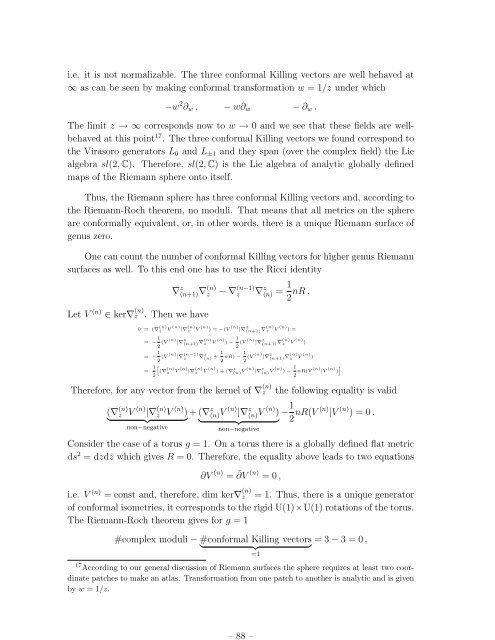Lectures on String Theory
Lectures on String Theory
Lectures on String Theory
You also want an ePaper? Increase the reach of your titles
YUMPU automatically turns print PDFs into web optimized ePapers that Google loves.
– 88 –<br />
i.e. it is not normalizable. The three c<strong>on</strong>formal Killing vectors are well behaved at<br />
∞ as can be seen by making c<strong>on</strong>formal transformati<strong>on</strong> w = 1/z under which<br />
−w 2 ∂ w , − w∂ w − ∂ w .<br />
The limit z → ∞ corresp<strong>on</strong>ds now to w → 0 and we see that these fields are wellbehaved<br />
at this point 17 . The three c<strong>on</strong>formal Killing vectors we found corresp<strong>on</strong>d to<br />
the Virasoro generators L 0 and L ±1 and they span (over the complex field) the Lie<br />
algebra sl(2, C). Therefore, sl(2, C) is the Lie algebra of analytic globally defined<br />
maps of the Riemann sphere <strong>on</strong>to itself.<br />
Thus, the Riemann sphere has three c<strong>on</strong>formal Killing vectors and, according to<br />
the Riemann-Roch theorem, no moduli. That means that all metrics <strong>on</strong> the sphere<br />
are c<strong>on</strong>formally equivalent, or, in other words, there is a unique Riemann surface of<br />
genus zero.<br />
One can count the number of c<strong>on</strong>formal Killing vectors for higher genus Riemann<br />
surfaces as well. To this end <strong>on</strong>e has to use the Ricci identity<br />
∇ z (n+1)∇ (n)<br />
z<br />
Let V (n) ∈ ker∇ (n)<br />
z . Then we have<br />
0 = (∇ (n)<br />
z<br />
− ∇ (n−1)<br />
z ∇ z (n) = 1 2 nR .<br />
V (n) |∇ (n)<br />
z V (n) ) = −(V (n) |∇ z (n+1) ∇(n) z V (n) ) =<br />
= − 1 2 (V (n) |∇ z (n+1) ∇(n) z V (n) ) − 1 2 (V (n) |∇ z (n+1) ∇(n) z V (n) )<br />
= − 1 2 (V (n) |∇ (n−1)<br />
z ∇ z (n) + 1 2 nR) − 1 2 (V (n) |∇ z (n+1) ∇(n) z V (n) )<br />
= 1 h<br />
(∇ (n)<br />
z<br />
2<br />
V (n) |∇ (n)<br />
z V (n) ) + (∇ z (n) V (n) |∇ z (n) V (n) ) − 1 2 nR(V (n) |V (n) i<br />
) .<br />
Therefore, for any vector from the kernel of ∇ (n)<br />
z<br />
the following equality is valid<br />
(∇ (n)<br />
z V (n) |∇ z (n) V (n) ) + (∇ z<br />
} {{ }<br />
(n)V (n) |∇ z (n)V (n) ) − 1 } {{ } 2 nR(V (n) |V (n) ) = 0 .<br />
n<strong>on</strong>−negative<br />
n<strong>on</strong>−negative<br />
C<strong>on</strong>sider the case of a torus g = 1. On a torus there is a globally defined flat metric<br />
ds 2 = dzd¯z which gives R = 0. Therefore, the equality above leads to two equati<strong>on</strong>s<br />
∂V (n) = ¯∂V (n) = 0 ,<br />
i.e. V (n) = c<strong>on</strong>st and, therefore, dim ker∇ z<br />
(n) = 1. Thus, there is a unique generator<br />
of c<strong>on</strong>formal isometries, it corresp<strong>on</strong>ds to the rigid U(1)×U(1) rotati<strong>on</strong>s of the torus.<br />
The Riemann-Roch theorem gives for g = 1<br />
#complex moduli − #c<strong>on</strong>formal Killing vectors = 3 − 3 = 0 ,<br />
} {{ }<br />
=1<br />
17 According to our general discussi<strong>on</strong> of Riemann surfaces the sphere requires at least two coordinate<br />
patches to make an atlas. Transformati<strong>on</strong> from <strong>on</strong>e patch to another is analytic and is given<br />
by w = 1/z.

















